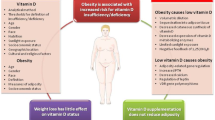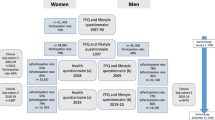Abstract
Insulin-like growth factor-I (IGF-I) stimulates osteoblast function, inhibits collagen matrix degradation, and is positively associated with bone mineral density in most but not all studies. We previously reported that IGF-I was positively associated with BMD at the spine and hip in women but not men. Insulin-like growth factor binding protein-1 (IGFBP-1), a potent modulator of IGF-I, is expressed in normal osteoblasts and inhibits collagen gene expression in bone, but little is known about the relationship between IGFBP-1 and bone mineral density (BMD). We report a cross-sectional study of serum IGFBP-1 levels and BMD in 1,139 community-dwelling men and postmenopausal women (not using estrogen), aged 44–98. In both sexes, IGFBP-1 levels increased linearly with age (p<0.001) and decreased with body mass index (BMI) quartile (p<0.001). After adjusting for age and BMI, there was no significant association between IGFBP-1 and BMD at the hip or spine. IGF-I and IGFBP-1 were weakly and inversely associated with each other. These findings suggest that if there is an important role for IGFBP-1 in bone metabolism, it is mediated or confounded by weight. Studies are needed to further investigate the relationship between inhibitory components of IGF-1 and bone loss.


Similar content being viewed by others
References
Rosen CJ, Donahue LR, Hunter SJ (1994) Insulin-like growth factors and bone: the osteoporosis connection. Proc Soc Exp Biol Med 206(2):83–102
Kim JG et al (1999) The relationship among circulating insulin-like growth factor components, biochemical markers of bone turnover and bone mineral density in postmenopausal women under the age of 60. Clin Endocrinol (Oxf) 51(3):301–307
Le Roith D (1997) Seminars in medicine of the Beth Israel Deaconess Medical Center. Insulin-like growth factors. N Engl J Med 336(9):633–640
Rechler MM, Clemmons D (1998) Regulatory actions of insulin-like growth factor-binding proteins. Trends Endocrinol Metab 9(5):176–183
Conover CA et al (1996) Insulin-like growth factor-binding protein-1 expression in cultured human bone cells: regulation by insulin and glucocorticoid. Endocrinology 137(8):3295–3301
Sugimoto T et al (1997) Serum levels of insulin-like growth factor (IGF) I, IGF-binding protein (IGFBP)-2, and IGFBP-3 in osteoporotic patients with and without spinal fractures. J Bone Miner Res 12(8):1272–1279
Nasu M et al (1997) Effect of natural menopause on serum levels of IGF-I and IGF-binding proteins: relationship with bone mineral density and lipid metabolism in perimenopausal women. Eur J Endocrinol 136(6):608–616
Barrett-Connor E, Goodman-Gruen D (1998) Gender differences in insulin-like growth factor and bone mineral density association in old age: the Rancho Bernardo Study J Bone Miner Res 13(8):1343–1349
Vestergaard P et al (1999 ) Effect of sex hormone replacement on the insulin-like growth factor system and bone mineral: a cross-sectional and longitudinal study in 595 perimenopausal women participating in the Danish Osteoporosis Prevention Study. J Clin Endocrinol Metab 84(7):2286–2290
Boonen S et al (2002) Musculoskeletal effects of the recombinant human IGF-I/IGF binding protein-3 complex in osteoporotic patients with proximal femoral fracture: a double-blind, placebo-controlled pilot study. J Clin Endocrinol Metab 87(4):1593–1599
Ljunghall S et al (1992) Low plasma levels of insulin-like growth factor 1 (IGF-1) in male patients with idiopathic osteoporosis. J Intern Med 232(1):59–64
Gillberg P et al (2002) Bone mineral density in femoral neck is positively correlated to circulating insulin-like growth factor (IGF)-I and IGF-binding protein (IGFBP)-3 in Swedish men. Calcif Tissue Int 70(1):22–29
Bennett AE et al (1984) Insulin-like growth factors I and II: aging and bone density in women. J Clin Endocrinol Metab 59(4):701–704
Donahue LR et al (1990) Age-related changes in serum insulin-like growth factor-binding proteins in women. J Clin Endocrinol Metab 71(3):575–579
Landin-Wilhelmsen K, Wilhelmsen L, Bengtsson BA (1999) Postmenopausal osteoporosis is more related to hormonal aberrations than to lifestyle factors. Clin Endocrinol (Oxf) 51(4):387–394
Jehle PM et al (2003) Serum levels of insulin-like growth factor (IGF)-I and IGF binding protein (IGFBP)-1 to -6 and their relationship to bone metabolism in osteoporosis patients. Eur J Intern Med 14(1):32–38
Ormarsdottir S et al (2001) Circulating levels of insulin-like growth factors and their binding proteins in patients with chronic liver disease: lack of correlation with bone mineral density. Liver 21(2):123–128
Parkhouse WS et al (2000) IGF-1 bioavailability is increased by resistance training in older women with low bone mineral density. Mech Ageing Dev 113(2):75–83
Ferrara A, Barrett-Connor EL, Edelstein SL (1994) Hyperinsulinemia does not increase the risk of fatal cardiovascular disease in elderly men or women without diabetes: the Rancho Bernardo Study, 1984–1991. Am J Epidemiol 140(10):857–869
Ito Y et al (2005) Stability of frozen serum levels of insulin-like growth factor-I, insulin-like growth factor-II, insulin-like growth factor binding protein-3, transforming growth factor-beta, soluble Fas, and superoxide dismutase activity for the JACC study. J Epidemiol 15 [Suppl 1]:S67–S73
Hanson DA et al (1992) A specific immunoassay for monitoring human bone resorption: quantitation of type I collagen cross-linked N-telopeptides in urine. J Bone Miner Res 7(11):1251–1258
Frystyk J et al (2002) Development and clinical evaluation of a novel immunoassay for the binary complex of IGF-I and IGF-binding protein-1 in human serum. J Clin Endocrinol Metab 87(1):260–266
Travers SH et al (1998) Insulin-like growth factor binding protein-I levels are strongly associated with insulin sensitivity and obesity in early pubertal children. J Clin Endocrinol Metab 83(6):1935–1939
Schneider DL, Barrett-Connor EL, Morton DJ (1997) Timing of postmenopausal estrogen for optimal bone mineral density. The Rancho Bernardo Study. JAMA 277(7):543–547
Helle SI et al (1996) Effects of oral and transdermal oestrogen replacement therapy on plasma levels of insulin-like growth factors and IGF binding proteins 1 and 3: a cross-over study. Clin Endocrinol (Oxf) 45(6):727–732
Carmina E et al (1996) Serum IGF-1 and binding proteins 1 and 3 in postmenopausal women and the effects of estrogen. Menopause: The Journal of The North American Menopause Society 3:85–89
Laughlin GA et al (2004) The prospective association of serum insulin-like growth factor I (IGF-I) and IGF-binding protein-1 levels with all cause and cardiovascular disease mortality in older adults: the Rancho Bernardo Study. J Clin Endocrinol Metab 89(1):114–120
Rutanen EM et al (1993) Aging is associated with decreased suppression of insulin-like growth factor binding protein-1 by insulin. J Clin Endocrinol Metab 77(5):1152–1155
Fatayerji D, Mawer EB, Eastell R (2000) The role of insulin-like growth factor I in age-related changes in calcium homeostasis in men. J Clin Endocrinol Metab 85(12):4657–4662
Weaver JU et al (1990) Decreased sex hormone binding globulin (SHBG) and insulin-like growth factor binding protein (IGFBP-1) in extreme obesity. Clin Endocrinol (Oxf) 33(3):415–422
Johansson AG et al (1992) The bone mineral density in acquired growth hormone deficiency correlates with circulating levels of insulin-like growth factor I. J Intern Med 232(5):447–452
Rosenfeld RG et al (1999) The insulin-like growth factor binding protein superfamily: new perspectives. Pediatrics 104(4)[Part 2]:1018–1021
Gosiewska A et al (1994) Evidence for an in vivo role of insulin-like growth factor-binding protein-1 and -2 as inhibitors of collagen gene expression in vitamin C-deficient and fasted guinea pigs. Endocrinology 134(3):1329–1339
Rosen CJ (2001) Insulin-like growth factor system and bone. Current Opinion in Endocrinology and Diabetes 8(6):277–282
Lee PD et al (1997) Insulin-like growth factor binding protein-1: recent findings and new directions. Proc Soc Exp Biol Med 216(3):319–357
Acknowledgements
This work was supported by research grant AG07181 from the National Institute on Aging and grant DK31801 from the National Institute of Diabetes and Digestive and Kidney Diseases
Author information
Authors and Affiliations
Corresponding author
Rights and permissions
About this article
Cite this article
Jassal, S.K., von Muhlen, D., Barrett-Connor, E. et al. Serum insulin-like growth factor binding protein-1 levels and bone mineral density in older adults: The Rancho Bernardo Study. Osteoporos Int 16, 1948–1954 (2005). https://doi.org/10.1007/s00198-005-1973-6
Received:
Accepted:
Published:
Issue Date:
DOI: https://doi.org/10.1007/s00198-005-1973-6




